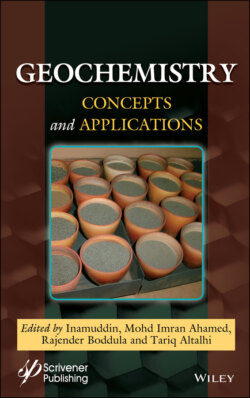Читать книгу Geochemistry - Группа авторов - Страница 6
Оглавление
Preface
Geochemistry is a branch of earth science. Since it is a field of study that uses the tools and principles of chemistry to explain the mechanisms in geologic environments, it often focuses on determining processes that control the abundance and composition of minerals and their distribution in the earth’s crust. Geochemistry also plays a vital role in environmental soil and water systems in identifying and modulating environmental problems, and in studying the composition, structure and processes of the earth. Therefore, this book helps in understanding the chemical composition of the earth and its applications. Since it explores the basic principles, concepts and applications of geochemistry and discusses its beneficial effects, bottlenecks, solutions, and future directions, it will be a very helpful reference source for undergraduate and postgraduate students, geochemists, environmentalists, chemists, researchers, engineers, R&D professionals, and faculties who are working in the fields of earth science, environmental chemistry and industrial technologies among others. In addition to case studies, topics such as chemical weathering, impacts on living beings and water, geochemical cycles, oxidation and redox reactions in geochemistry, isotopes, analytical techniques, medicinal, inorganic, marine, atmospheric, and environmental applications are presented. The information contained in the chapters summarized below was written by experts in the field from around the world, making it a unique archival reference guide.
Chapter 1 discusses the nature and occurrence of toxic geogenic contaminants in serpentinite geological systems. Human exposure pathways in occupational and non-occupational settings are then summarized and their human health risks are also presented. Finally, mitigation measures to reduce human health risks are discussed and future research directions are proposed.
Chapter 2 reports detailed information on the application of essential minerals for the treatment of human diseases, including dental problems, cancer, hypertension, cardiovascular diseases, and goiters. Special attention is also paid to the application of essential elements for the management of animal and plant diseases.
Chapter 3 highlights the benefits of the application of geochemistry in livestock, especially in the adequate maintenance of animal health and animal nutrition. The significance of numerous minerals that play several roles in the effective production of livestock is especially highlighted.
Chapter 4 provides detailed information on the significance of geochemistry in the identification of useful mineral elements which could boost agricultural production and their significant role in the decontamination of heavily polluted soil and water, as well as their benefits especially in the area of sustainable agriculture.
Chapter 5 details the cases of heavy metal contamination in soil using the ecological risk index. The major focus is the geochemistry and environmental impacts of arsenic, cadmium, chromium, copper, lead, nickel and zinc. The transfer of contaminants from sources to the higher trophic levels of the food chain is also summarized.
Chapter 6 discusses the geochemical applications of both traditional and non-traditional stable isotopes. Beginning with basic definitions, the chapter goes on to discuss the variety of applications of traditional stable isotopes, geothermometers, tracers in hydrological and biological systems, ore deposits, hydrothermal systems, etc., and some applications of non-traditional stable isotopes.
Chapter 7 is an overview of the research outcomes of the last decades and how geochemistry affects the sustainability of the environment and causes pollution at different levels. This chapter also explains the geochemical reactions of environmental pollutants and the physicochemical characteristics of various types of environmental samples.
Chapter 8 focuses on the development of geochemistry and its distinct branches, as isotopic geochemistry reveals information about environmental health to avoid harmful chemicals that have antagonistic effects on health. Also discussed is the role of medical geochemistry in addressing many environmental health problems.
Chapter 9 discusses the importance of inorganic geochemistry, the rock-forming minerals and their compositions. The characterization of minerals, elemental analysis and the determination of composition are elaborated. Clay minerals and their applications are also explained.
Chapter 10 discusses the periodic properties such as ionization energy, electronegativity, electron affinity and influence on the chemical bond formation among the elements. The distribution of elements in different layers present on the earth which depends on factors like temperature, pressure and altitude are discussed. Several subdisciplines and the scope of geochemistry are also presented.
The Editors February 2021
